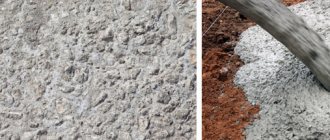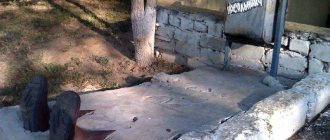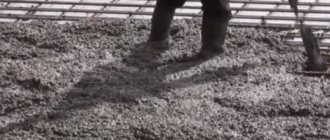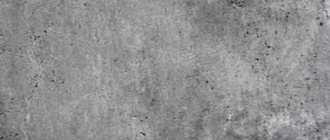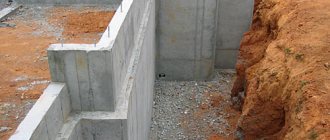Heavy concrete grade M250 corresponds to class B20 according to the international classification system. The compliance of the class and grade of concrete is established by state standards based on the results of expert studies and laboratory tests. When producing the M250(B20) mixture, the technical characteristics that are the same for both methods of determining the brand composition must be observed. The buyer is also provided with accompanying documents for the batch of concrete, taking into account both grade M250 and class B20.
Composition and proportions
Grade M250 refers to heavy types of concrete, containing the following components:
- binder – Portland cement of medium quality;
- coarse filler – crushed stone (granite, gravel, limestone);
- fine filler - river or quarry sand;
- water without impurities;
- chemical additives to impart specific properties to the solution (plasticizer, antifreeze additives, accelerating or slowing down the additive hardening process).
To obtain high-quality M250 concrete, you need to adhere to the following formula:
- 1 part cement;
- 3.8 parts clean sand;
- 2.3 parts of crushed stone.
Concrete grade M250
Definition and characteristics
Heavy class B20 M250 concrete is used for pouring slabs and platforms.
Concrete is one of the most popular building materials, especially in the context of modern technologies, where the share of monolithic construction is constantly growing. In addition, the demand for prefabricated reinforced concrete products, which also use the M250 concrete composition, is constantly increasing.
As you know, concrete is a stone-like material of artificial origin, which is obtained after hardening a dry mixture mixed with water, which consists of cement, crushed stone, sand and some additives. One of the main characteristics of such a material is its compressive strength.
Determination of compressive strength.
To determine this strength of concrete, a cube of hardened concrete stone with a side of 150 mm is subjected to a pressure test, as a result of which the average value of the force applied per square centimeter of the surface of the product is determined, which this cube can withstand without serious damage. The value of the applied force is indicated in the marking with some approximation.
In our case, the M250 brand means that we have a material with a compressive strength within 250 kgf/sq. cm, or to be more precise, 262 kgf/sq. cm.
Important! It must be said that this is rather scant information indicating the general class of the material and its compressive strength. To clarify additional parameters such as water resistance, frost resistance, tensile and bending strength, bulk density, mobility, etc. knowledge of other indicators is required.
The photo shows the relationship between classes and grades of concrete with an indication of compressive strength.
According to the CMEA St. classification, the M250 brand corresponds to class B20, which is considered the main level of this classification, while M250 in our country belongs to intermediate brands and is therefore not used often, which explains the low popularity and low demand for this product.
The main technical characteristics of the material can be presented in the form of the following list:
- Brand – M250;
- Class – B20;
- Compressive strength – 262 kgf/cm2;
- Frost resistance – F100 – F150, when using granite crushed stone – F The use of special additives can increase this indicator to the required value;
- Water resistance - W The use of granite crushed stone can increase water resistance to the value of W6, further increase is possible with the use of special additives - water repellents, plasticizers and pozzolans;
- The density of M250 concrete is approximately 2350 kg/m3, which allows it to be classified as a heavy grade. However, the specific gravity of M250 concrete may vary depending on the aggregates used, the water-cement ratio and the method of compacting the mortar, as well as compacting additives;
- The mobility of ready-mixed concrete of the named brand varies depending on the requirements of casting and composition and can take values P2, P3, P4.
Surface structure of concrete stone grade M250.
Important! Based on the list of characteristics, we can define this type of concrete as a heavy material of average strength and frost resistance, average water resistance and normal mobility, which makes it absolutely acceptable for civil engineering.
Compound
The quality of the mixture depends on the correct selection of components.
We are considering the classic case of cement concrete, so its composition does not differ from other similar materials.
To prepare this type of concrete solution, the following components are used:
- Astringent . Portland cement of the M400 – M500 grades is used here, which makes it possible to achieve the most optimal water-cement ratio, while the price of the solution remains acceptable;
- Fine aggregate . Various types of natural sand are used, previously washed from clay and dust particles. There are no special requirements for it; compliance with GOST 8736-93 is sufficient;
- Large aggregate . They use gravel, limestone and crushed granite, with the first type being the most common; limestone is considered less durable and frost-resistant, and granite is too expensive. Crushed stone must be tested for strength, frost resistance and water resistance; it is desirable that these indicators exceed the standards for concrete of this grade by approximately two times;
- Special additives . The content of plasticizers in the production of ready-mixed concrete must be at least 5.8 kg/m3 according to GOST 8736-93. In addition, air-entraining, sealing, water-repellent, antiseptic and other targeted additives are added to the composition.
Important! If you plan to cut reinforced concrete with diamond wheels, grind or diamond drill holes in concrete, then it is better to use crushed limestone, as it is more amenable to such processing.
Table of ratios of solution components.
The composition and proportions of M250 concrete per 1 m3 according to the state standard are 1: 2.1: 3.9 by mass and 1: 1.9: 3.4 by volume for cement grade M400.
If you use M500 cement, then this ratio will be 1:2.6:4.5 by weight and 1:2.4:3.9 by volume.
Important! If you need to comply with a project where this particular brand is indicated, you should order delivery of ready-mixed concrete to the site. When making a solution with your own hands, the instructions require mandatory testing of the finished product in the laboratory, otherwise it is impossible to assign a brand to it.
Production technology
The production of mortar for any brand of concrete is identical. It is only important to comply with all technological conditions. Then you will get a high-quality solution of the required consistency, which will ensure the durability and strength of the structure being poured.
Even a small error in the production process can lead to a decrease in the quality properties of concrete.
The process of producing concrete for private and industrial construction is almost the same and includes a strict procedure:
- Preparation of the main components of the solution. Includes washing, cleaning and sifting of dry fillers - sand and crushed stone. The water is filtered to prevent the presence of various suspensions and particles in it. Portland cement is suitable only for recently produced cement, which has not yet had time to compact and form lumps.
- Mixing components. First, the dry fillers and Portland cement are mixed. Lastly, add water and mix until smooth.
In private construction, mixing can be done manually or in a small-volume concrete mixer. Concrete plants use concrete mixers (planetary, twin-roll, disc), which allow mixing huge volumes of mortar.
Uniform distribution of components in the solution guarantees the strength and durability of the structures being poured.
- Compliance with technological production conditions. Kneading should be done at a temperature of 20 ℃ and a humidity of 40-60%. It is important to maintain these indicators throughout the entire time – from mixing the components to delivering the concrete to the construction site. Otherwise, the mixture will separate and it will lose its properties.
The cement is mixed until smooth. For private construction, the mixing time depends on the fraction of the components. In factory conditions, this is solved computerized - depending on the application and the scope of application of the concrete.
Proportions and preparation
Having familiarized yourself with what concrete M250 (B20) consists of, you need to find out the correct calculation of the composition per cubic meter. In the example below, M500 grade cement, clean water, medium-sized granite crushed stone, and river sand without harmful impurities are used.
For a cube of material, the proportions will be as follows: 1 (C): 2.6 (P): 4.5 (W) (when calculating by weight), or 1 (C): 2.4 (P): 3.9 (Ш) when calculated depending on the volume.
The M250 concrete mix grade is an excellent solution for various areas of construction. It has average strength characteristics, but a good price-quality ratio.
Properties and characteristics
Technical characteristics of concrete grade M250 are indicated in GOST 7473-2010. This is the main document regulating the production parameters of building materials. The main characteristics of concrete grade M250:
- in terms of compressive strength, the indicator of which is 200 kg/cm2, corresponds to class B20;
- the finished product can withstand up to 200 cycles of freezing followed by defrosting, which classifies M400 concrete in frost resistance class F150-F200. The figure depends on the type of coarse aggregate;
- The average ability to retain moisture provided an indicator for water resistance class W2-W6. It can be increased if a water repellent is added to the solution;
- the finished solution has good mobility - P2-P4.
Composition of concrete M-250 (B20)
To ensure that concrete exactly meets the required criteria, the following components are added to the composition:
- cement M400-M500 as a binding component;
- sand of 1-2 classes, cleared of large fractions;
- crushed stone (limestone, gravel, granite chips);
- additives;
- pure water.
The weight of a cube of concrete depends on the coarse aggregate used in the batch. As a rule, crushed stone of different fraction sizes is introduced into the composition so that the internal volume is more dense, and therefore provides the maximum load resistance allowed for the brand.
In percentage terms, according to the standards established for class B20, the following components are introduced (by weight c/p/w):
- for PCM400: 1/1.9/3.4;
- for PCM500: 1/2.4/3.9.
By purchasing M250 concrete at the plant, the customer receives a passport and product certificate. Official documents reflect all significant indicators by brand and class of concrete. The supplier guarantees the consumer properties of its products, since the safety and duration of the subsequent operation of the facility depend on compliance with standards.
Areas and features of application
Concrete grade M250 is used in:
- pouring strip and monoblock foundations of mid-rise buildings;
- arrangement of staircases;
- concreting floor slabs;
- filling areas for parking and pedestrian paths;
- pouring structures supporting pipelines and bridge supports with light traffic.
Concrete grade M250 is an intermediate type between grades M200 and M300. But due to its higher price and similar properties to M200 and M300, it is not often used by builders.
Characteristics of brands
Today the presented product exists in a wide range. Concrete of a specific brand has its own technical indicators and scope of application. According to strength indicators, concrete can be M50-M800. Minimum numerical values are considered less durable. As a rule, they are used during preparatory activities.
How heavy concrete GOST 26633 2012 is used is indicated in the article.
We determine the technological characteristics for each brand of concrete:
- M100 – used in the production of blind areas, as well as as a basis before reinforcing work. Water absorption level is W2, and frost resistance is F25.
- M200 – concrete, which is used in the construction of structures that require greater strength. Today this brand is considered the most popular and widely in demand. This material is used in the construction of columnar, strip and monolithic foundations. M200 is also used in the production of foundation blocks and floors. Frost resistance for such products is characterized by F100, and water absorption by W4.
- M300 (B22.5) – concrete, which is actively used in the construction of the strip base. Such products have gained wide demand for the production of monolithic walls, floor slabs, stairs, and fences. The degree of frost resistance is F100-F200, but the water absorption level is W6.
- M350 – a product that is used in the production of monolithic foundations, walls, piles, blocks, columns and ceilings. Another material began to be used in the manufacture of reinforced concrete products. The level of frost resistance is F200, and the degree of water absorption is W6
- M450 (B35) - concrete, which is not always convenient to use in construction due to its rapid setting. In addition, such material cannot be considered economically profitable. For this reason, M450 concrete has not gained high popularity in civil engineering. Most often it is used in the construction of dams, subways, and dams. The degree of frost resistance is F300, but the degree of water absorption is W12.
- M500 and M550 . This material has high strength indicators; cement is present in large quantities in the composition of such concrete. Such brands are used in hydraulic engineering construction and in the production of reinforced concrete structures for special purposes.
You can learn how to make a shallow strip foundation for a house made of aerated concrete from this article.
Table 1 - Application of concrete taking into account frost resistance group
| Frost resistance group | Designation | Scope of use |
| Low | less than F50 | Not very popular |
| Moderate | F50 – F150 | The frost resistance and water resistance of the material in this group has optimal characteristics. The presented products are widely used. |
| Increased | F150 – F300 | Due to its high level of frost resistance, such concrete can be used for laying foundations in harsh climates. |
| High | F300 – F500 | This product can be used when laying foundations with variable humidity. |
| Particularly high | over F500 | Such high frost resistance is achieved thanks to the injection method of special additives. Used in the construction of durable structures. |
One of the methods for determining the frost resistance of concrete according to GOST 10060 2012 is to keep it in a freezer at a certain temperature.
Proportions
Calculating the proportions of grade 250 concrete is easy. In this example, the components will be taken in standard volumes, based on the following conditions: cement corresponds to grade M500, purified water, granite crushed stone of fractions from 5 to 20 acts as a coarse aggregate, and river sand without any impurities or clay as a fine aggregate.
In order for the concrete to harden perfectly and then not have to find out during the research process what grade it turned out to be, you need to add about 30% of the weight of the cement with water. True, such a solution will be difficult to install due to dryness, so usually concrete B20 (M250) assumes a water-cement ratio within 0.62 (provided that M500 grade cement is used).
Types of concrete and their classification
Based on the binder component used in the mixture, concrete is divided into cement, lime, gypsum, asphalt, silicate, clay, etc.
The presence of dust and organic inclusions in the filler reduces the strength of concrete
The use of certain fillers divides concrete into types:
- heavy (gravel, crushed stone from dense rocks, used in concrete and reinforced concrete structures);
- especially heavy (iron ore, barite, used for the military, nuclear power plants, landfills);
- light (natural slag pumice, found application in coatings and fences);
- especially light (foam concrete or aerated concrete).
Based on their properties, concrete is divided into waterproof, frost-resistant and fire-resistant; the degree of density of the concrete mixture divides it into rigid and plastic.
In each type of construction it is necessary to use concrete of the appropriate class and grade
Proportions of concrete M250
The number of components required to prepare 1 m3 is of practical importance if the concrete solution is prepared directly on the construction site by the developer’s own resources. Material corresponding to the M250 concrete grade, supplied ready-made from the concrete plant, is tested in the factory laboratory, so it can be immediately used for its intended purpose.
To prepare 1 cube of M250 concrete you will need:
When mixing small volumes of material, the generally accepted unit of measurement for concrete components is the “bucket.” Therefore, it will be useful for a private developer to know the proportions of the composition of concrete m 250 in 10-liter buckets. To determine this value, we set the following initial data:
We reduce the capacity of the bucket in liters to the capacity in m3: 10/1000 = 0.01 m3. Let's determine how many kg of cement, crushed stone and sand fit in a ten-liter bucket:
Using the ratio of components C: W: P: W, we calculate how many m3 of concrete can be prepared from one 10 liter bucket of cement:
Knowing the proportions of M250 concrete per 1 m3, you can calculate the approximate cost of making it yourself and compare it with the price of ready-made concrete produced in a factory. We ask the prices of the main components in Moscow and the Moscow region:
Cost of 1 m3 of M 250 concrete produced on our own: (295x3.6)+(1,115x1.63)+(690x0.17)+(190x0.035)=3,002 rubles. Let's compare the average price of factory-made concrete with the price of home-made concrete: 100-((3002x100)/(4,250+4,400/2))=100-69.4=30.6%. Self-production of M 250 concrete will cost the developer 30.6% less than purchasing ready-made concrete.
Many developers will ask a legitimate question: “Where did such a significant difference in cost come from?” The fact is that the cost of factory-made concrete includes cost items that are not included in the cost of self-made concrete: wages, depreciation of equipment, buildings and structures, electricity, renovation (full restoration) of equipment, profit, taxes and mandatory contributions to government funds, and other production and non-production expenses.
Source
Table of prices for concrete by brand (class) with characteristics
| Brand (class) | Frost resistance, F | Water resistance, W | Price | Order |
| Concrete M100 B7.5 | F 50 | W 2 | RUB 2,920/m3 | Add to cart |
| Concrete M150 B12.5 | F 50 | W 2 | RUB 3,040/m3 | Add to cart |
| Concrete M200 B15 | F 100 | W 4 | RUB 3,240/m3 | Add to cart |
| Concrete M250 B20 | F 100 | W 4 | RUB 3,550/m3 | Add to cart |
| Concrete M300 B22.5 | F 200 | W 6 | RUB 3,590/m3 | Add to cart |
| Concrete M350 B25 | F 200 | W 8 | RUB 3,770/m3 | Add to cart |
| Concrete M400 B30 | F 300 | W 10 | RUB 3,900/m3 | Add to cart |
| Concrete M450 B35 | F 200-300 | W 8-14 | 4,010 rub./m3 | Add to cart |
| Concrete M500 B40 | F 300 | W 12 | 4,270 rub./m3 | Add to cart |
Concrete classes
The accepted grades of concrete and their use are directly related to the class, which indicates the compressive strength of the building material. As mentioned above, the letter B is used for designation, and specific indicators are calculated in megapascals. If, suppose, the concrete has a class B10, this means that a concrete cube with sides of 150 mm is capable of withstanding a pressure of 10 MPa.
To find out the class of a building material, you need to know its brand and use correction factors. Calculations are made using the formula:
B = R*(0.0980655*(1 – 1.64*V)), where:
- V is the correction factor;
- R – brand;
- 0.0980655 – coefficient used to convert one unit of measurement to another (MPa and kgf/cm²).
For most concrete mixtures, the V number is 13.5%. When constructing hydraulic structures, materials are used whose coefficient is 17%.
